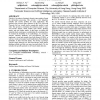Free Online Productivity Tools
i2Speak
i2Symbol
i2OCR
iTex2Img
iWeb2Print
iWeb2Shot
i2Type
iPdf2Split
iPdf2Merge
i2Bopomofo
i2Arabic
i2Style
i2Image
i2PDF
iLatex2Rtf
Sci2ools
SOUPS
2006
ACM
2006
ACM
The methodology and an application to fight against Unicode attacks
Unicode is becoming a dominant character representation format for information processing. This presents a very dangerous usability and security problem for many applications. The problem arises because many characters in the UCS (Universal Character Set) are visually and/or semantically similar to each other. This presents a mechanism for malicious people to carry out Unicode Attacks, which include spam attacks, phishing attacks, and web identity attacks. In this paper, we address the potential attacks, and propose a methodology for countering them. To evaluate the feasibility of our methodology, we construct a Unicode Character Similarity List (UC-SimList). We then implement a visual and semantic based edit distance (VSED), as well as a visual and semantic based Knuth-Morris-Pratt algorithm (VSKMP), to detect Unicode attacks. We develop a prototype Unicode attack detection tool, IDN-SecuChecker, which detects phishing weblinks and fake user name (account) attacks. We also introduce ...
| Added | 14 Jun 2010 |
| Updated | 14 Jun 2010 |
| Type | Conference |
| Year | 2006 |
| Where | SOUPS |
| Authors | Anthony Y. Fu, Xiaotie Deng, Liu Wenyin, Greg Little |
Comments (0)

